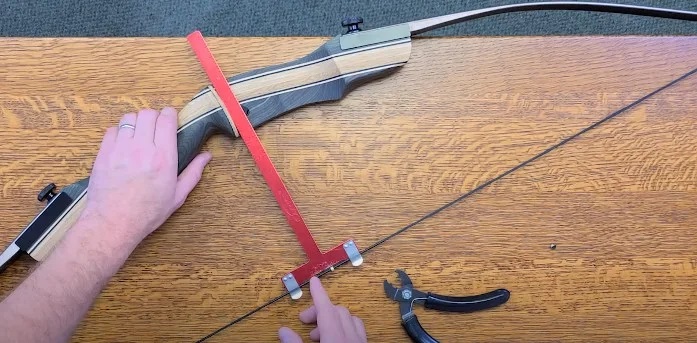Archery, an ancient art and sport, requires precision and accuracy. Whether you’re a beginner or a seasoned archer, mastering the basics is essential for success. One such fundamental tool in an archer’s arsenal is the bow square. This simple yet indispensable device helps ensure consistency and precision in bow setup, string alignment, and arrow tuning. In this guide, we’ll delve into the intricacies of using a bow square effectively, covering its purpose, different types, and step-by-step instructions on how to utilize it to enhance your archery performance.
Understanding the Bow Square:
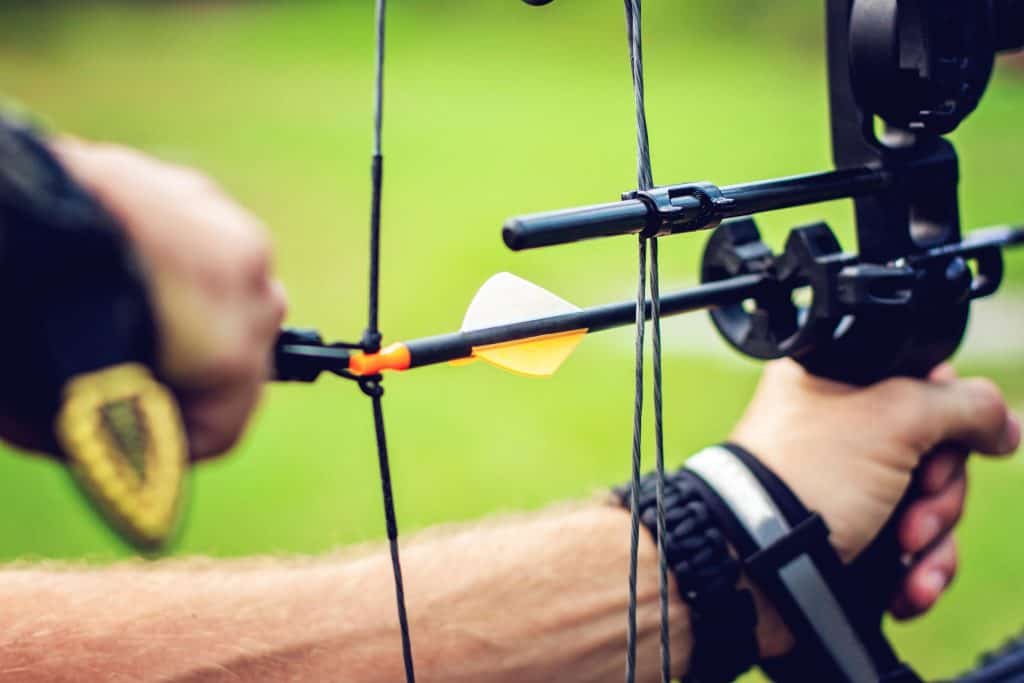
Before delving into its usage, it’s crucial to understand what a bow square is and its significance in archery. A bow square is a small, L-shaped tool typically made of durable materials such as aluminum or plastic. It comprises a ruler with measurements marked in inches or centimeters and two perpendicular arms, one shorter than the other. The longer arm is used to attach the bow square to the bowstring, while the shorter arm rests against the bow’s riser.
Purpose of a Bow Square:
The primary purpose of a bow square is to ensure the proper alignment of the bow’s components, namely the bowstring, arrow rest, and nocking point. By providing accurate measurements, it aids in achieving consistent arrow flight and optimal arrow clearance, ultimately enhancing accuracy and precision. Additionally, a bow square facilitates various tuning adjustments, such as brace height, tiller, and nocking point placement, allowing archers to fine-tune their equipment for optimal performance.
Types of Bow Squares:
Bow squares come in several variations, each designed to cater to specific needs and preferences. The most common types include:
- T-shaped Bow Square: This traditional bow square features a T-shaped design with a ruler attached perpendicular to the bowstring, providing precise measurements for string alignment and brace height adjustments.
- L-shaped Bow Square: Similar to the T-shaped bow square, the L-shaped bow square features a ruler perpendicular to the bowstring. However, it has a shorter arm, making it more compact and convenient for travel.
- Clip-on Bow Square: As the name suggests, this type of bow square clips onto the bowstring, eliminating the need for manual attachment. It often features a sliding ruler for easy adjustment and precise measurement.
- Magnetic Bow Square: Utilizing magnets for attachment, this innovative bow square offers quick and secure positioning on the bowstring. It is particularly popular among recurve and traditional archers for its convenience and ease of use.
Regardless of the type, selecting a bow square that suits your needs and preferences is essential for accurate measurements and optimal performance.
1. T-shaped bow square
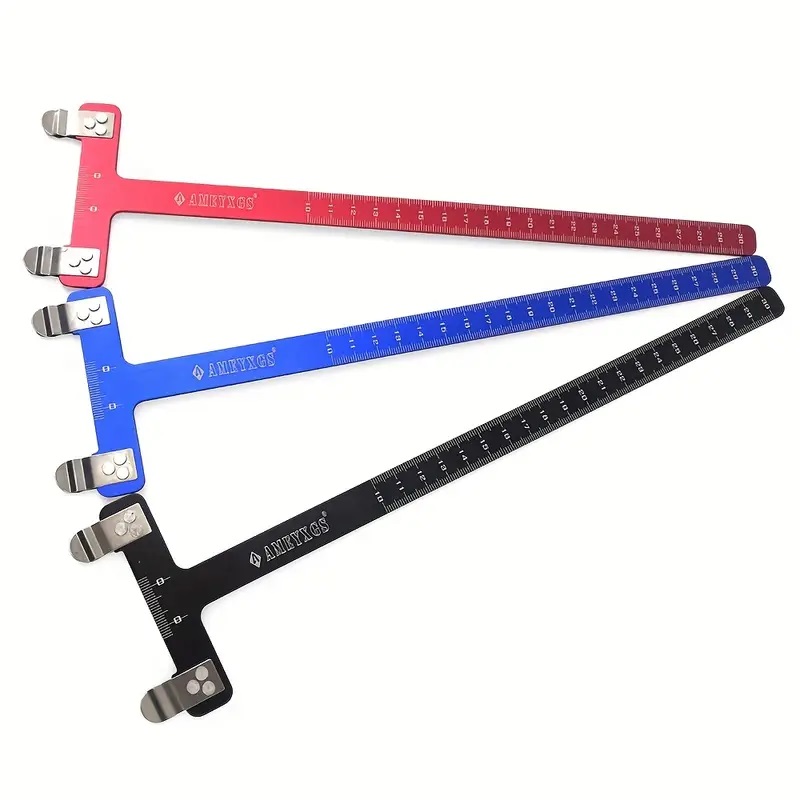
The T-shaped bow square is a traditional and widely used tool in the world of archery. As its name suggests, it features a T-shaped design, consisting of a ruler perpendicular to the bowstring. This simple yet effective design allows archers to accurately measure and adjust various aspects of their bow setup.
Key Features:
- Ruler: The ruler on the T-shaped bow square is the primary feature, providing precise measurements in inches or centimeters. It typically extends perpendicular to the bowstring, allowing archers to measure important parameters such as brace height and arrow nocking point.
- Attachment Point: At the top of the T-shaped bow square is a notch or hook designed to securely attach to the bowstring. This attachment point ensures stability and prevents the bow square from sliding or moving during measurements.
- Compact Design: The T-shaped bow square is often compact and lightweight, making it easy to carry in a quiver or archery kit. Its simplicity and portability make it a popular choice among archers of all skill levels.
- Durability: Constructed from durable materials such as aluminum or plastic, the T-shaped bow square is built to withstand the rigors of regular use. Its sturdy construction ensures longevity, providing archers with a reliable tool for years to come.
- Versatility: Despite its simple design, the T-shaped bow square is versatile and can be used for a variety of purposes. From measuring brace height and arrow nocking point to checking arrow alignment, it serves as an indispensable tool for bow tuning and setup.
Advantages:
- Precise Measurements: The ruler on the T-shaped bow square allows archers to make accurate measurements, ensuring consistency and optimal bow performance.
- Ease of Use: With its straightforward design, the T-shaped bow square is easy to use, making it suitable for archers of all experience levels.
- Portability: Its compact size and lightweight construction make the T-shaped bow square easy to carry and transport, allowing archers to make adjustments on the go.
- Cost-Effective: T-shaped bow squares are often affordable, making them an accessible option for archers on a budget.
Disadvantages:
- Limited Features: While effective for basic measurements, the T-shaped bow square may lack some advanced features found in other types of bow squares, such as clip-on or magnetic varieties.
- Manual Attachment: Unlike clip-on or magnetic bow squares, the T-shaped bow square requires manual attachment to the bowstring, which may be slightly more time-consuming.
Overall, the T-shaped bow square is a reliable and versatile tool that plays a crucial role in bow tuning and setup. Its simplicity, accuracy, and affordability make it a popular choice among archers seeking to enhance their performance on the range or in the field.
2. L-shaped bow square
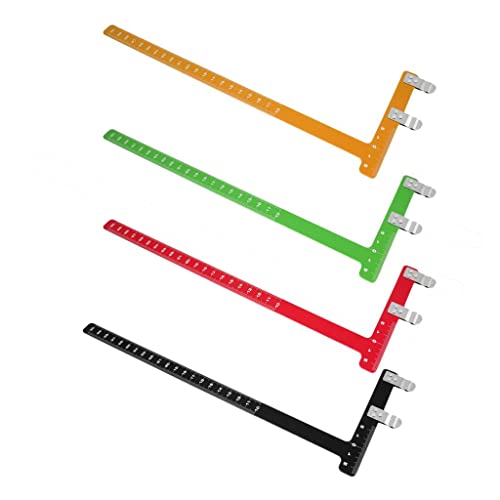
The L-shaped bow square is another commonly used tool in archery, renowned for its simplicity and effectiveness in bow setup and tuning. This bow square, as the name suggests, features an L-shaped design, with one arm serving as the attachment point to the bowstring and the other arm housing the ruler for measurements.
Key Features:
- L-shaped Design: The defining characteristic of the L-shaped bow square is its L-shaped configuration. One arm of the L is shorter and serves as the attachment point to the bowstring, while the longer arm houses the ruler for measurements. This design allows for easy attachment and precise measurements.
- Ruler: Like other bow squares, the L-shaped bow square features a ruler for accurate measurements. The ruler is typically marked with measurements in inches or centimeters, allowing archers to measure parameters such as brace height and arrow nocking point with precision.
- Attachment Point: The shorter arm of the L-shaped bow square is designed to attach securely to the bowstring. This attachment point ensures stability during measurements and prevents the bow square from slipping or moving.
- Compact and Lightweight: Similar to the T-shaped bow square, the L-shaped bow square is often compact and lightweight, making it convenient to carry in a quiver or archery kit. Its portability allows archers to make adjustments on the range or in the field with ease.
- Durability: L-shaped bow squares are typically constructed from durable materials such as aluminum or plastic, ensuring longevity and reliability. Despite their lightweight design, they are built to withstand the rigors of regular use.
Advantages:
- Simple and Effective: The L-shaped bow square’s straightforward design makes it easy to use, even for beginners. Its simplicity does not compromise its effectiveness in measuring and adjusting key parameters of bow setup.
- Portable: With its compact size and lightweight construction, the L-shaped bow square is easy to carry and transport, allowing archers to make adjustments wherever they go.
- Affordable: L-shaped bow squares are often affordable, making them accessible to archers on a budget. Despite their lower cost, they provide accurate measurements and reliable performance.
Disadvantages:
- Limited Features: Similar to the T-shaped bow square, the L-shaped bow square may lack some advanced features found in other types of bow squares, such as clip-on or magnetic varieties.
- Manual Attachment: As with the T-shaped bow square, the L-shaped bow square requires manual attachment to the bowstring, which may be slightly more time-consuming compared to clip-on or magnetic bow squares.
3. Clip-on bow square
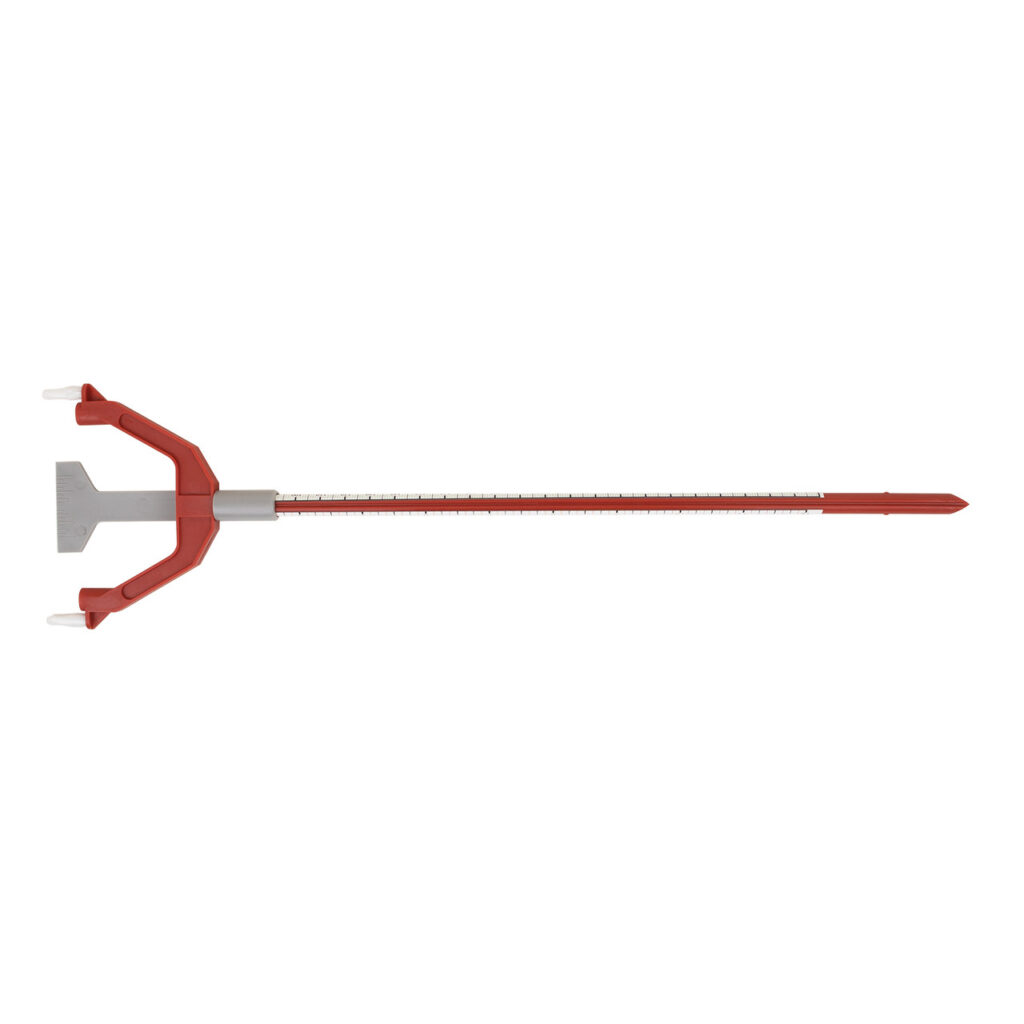
The clip-on bow square is a modern and convenient tool designed to streamline the process of bow tuning and setup. Unlike traditional T-shaped or L-shaped bow squares, the clip-on bow square features a unique design that allows for quick and effortless attachment to the bowstring.
Key Features:
- Clip-on Design: The defining feature of the clip-on bow square is its clip mechanism, which allows for easy attachment to the bowstring. This clip securely grips the bowstring, eliminating the need for manual attachment and ensuring stability during measurements.
- Sliding Ruler: Many clip-on bow squares feature a sliding ruler mechanism that allows for easy adjustment and precise measurements. The ruler is typically marked with measurements in inches or centimeters, enabling archers to measure parameters such as brace height and arrow nocking point accurately.
- Compact and Lightweight: Clip-on bow squares are often compact and lightweight, making them easy to carry in a quiver or archery kit. Their portable design allows archers to make adjustments on the range or in the field with minimal hassle.
- Durability: Clip-on bow squares are typically constructed from durable materials such as aluminum or plastic, ensuring longevity and reliability. Despite their lightweight construction, they are built to withstand the rigors of regular use.
Advantages:
- Easy Attachment: The clip-on design of the bow square allows for quick and effortless attachment to the bowstring, saving time and effort during the setup process.
Secure Grip: The clip mechanism securely grips the bowstring, providing stability during measurements and preventing slippage or movement. - Precise Measurements: Many clip-on bow squares feature a sliding ruler mechanism that allows for easy adjustment and precise measurements. This enables archers to achieve optimal bow setup and tuning with accuracy.
- Portable: With their compact size and lightweight construction, clip-on bow squares are easy to carry and transport, making them ideal for use on the range or in the field.
Disadvantages:
- Cost: Clip-on bow squares may be slightly more expensive than traditional T-shaped or L-shaped bow squares due to their additional features and convenience.
- Dependency on Clip Mechanism: The clip mechanism is a critical component of the bow square, and any malfunction or damage to the clip could affect its performance and reliability.
4. Magnetic bow square

The magnetic bow square represents a modern innovation in archery equipment, offering convenience, efficiency, and precision in bow tuning and setup. This type of bow square utilizes magnetic attachment mechanisms, which securely and swiftly adhere to the bowstring without the need for manual clamping or clipping.
Key Features:
- Magnetic Attachment: The most distinctive feature of the magnetic bow square is its use of magnets to attach to the bowstring. These magnets provide a strong and reliable connection, ensuring stability during measurements without the risk of slippage or displacement.
- Adjustable Arm: Many magnetic bow squares feature an adjustable arm or sliding mechanism that allows for easy positioning and precise measurements. This adjustable arm typically houses a ruler marked with measurements in inches or centimeters, facilitating accurate adjustments of brace height and arrow nocking point.
- Compact and Lightweight: Magnetic bow squares are often compact and lightweight, making them easy to carry in a quiver or archery kit. Their portable design allows archers to make adjustments on the range or in the field with minimal effort.
- Durability: Magnetic bow squares are typically constructed from durable materials such as aluminum or plastic, ensuring longevity and reliability. Despite their lightweight construction, they are built to withstand the rigors of regular use.
Advantages:
- Quick and Easy Attachment: The magnetic attachment mechanism of the bow square allows for swift and effortless attachment to the bowstring, saving time and effort during the setup process.
- Secure Connection: The strong magnetic connection ensures stability during measurements, preventing slippage or movement and facilitating accurate adjustments.
- Precise Measurements: The adjustable arm or sliding mechanism of the magnetic bow square enables archers to make precise measurements of parameters such as brace height and arrow nocking point, ensuring optimal bow setup and tuning.
- Portability: With their compact size and lightweight construction, magnetic bow squares are easy to carry and transport, making them ideal for use on the range or in the field.
Disadvantages:
- Cost: Magnetic bow squares may be more expensive than traditional T-shaped or L-shaped bow squares due to their advanced features and convenience.
- Dependency on Magnets: The performance and reliability of the magnetic bow square are dependent on the integrity of the magnets. Any damage or malfunction to the magnets could affect the stability and accuracy of measurements.
Step-by-Step Guide on Using a Bow Square:

Now that we’ve covered the basics let’s delve into the step-by-step process of using a bow square effectively:
Step 1:
Attach the Bow Square to the Bowstring: Begin by attaching the longer arm of the bow square to the bowstring, ensuring it sits securely against the string.
Step 2:
Position the Bow Square: With the bow square attached to the string, position the shorter arm against the bow’s riser, ensuring it rests firmly without any movement.
Step 3:
Measure Brace Height: Brace height refers to the distance between the bowstring and the deepest part of the bow’s grip. To measure brace height, use the ruler on the bow square to determine the distance between the bowstring and the pivot point of the grip. Adjust the brace height by twisting the bowstring or using a bow square with a sliding ruler for precise adjustments.
Step 4:
Adjust Nocking Point: The nocking point is the point on the bowstring where the arrow is placed. To ensure proper arrow nocking, use the ruler on the bow square to measure the distance between the arrow rest and the nocking point. Adjust the nocking point up or down as needed to achieve optimal arrow flight and clearance.
Step 5:
Check Arrow Alignment: Once the brace height and nocking point are adjusted, check the alignment of the arrow rest and the arrow shaft. The arrow should sit perpendicular to the bowstring, ensuring consistent arrow flight and accuracy.
Step 6:
Fine-Tune as Needed: After making initial adjustments, it’s essential to fine-tune the bow setup based on your shooting style and preferences. Experiment with small adjustments to brace height, nocking point, and arrow rest position to achieve optimal performance.
In conclusion, a bow square is a valuable tool for archers of all skill levels, providing precise measurements and facilitating crucial adjustments for optimal bow setup and performance. By understanding its purpose, different types, and how to use it effectively, archers can enhance their accuracy, consistency, and overall enjoyment of the sport. Incorporate the tips and techniques outlined in this guide into your archery routine to take your skills to new heights and unleash your full potential on the range or in the field. Check out our other blogs to know more about hunting tricks.
